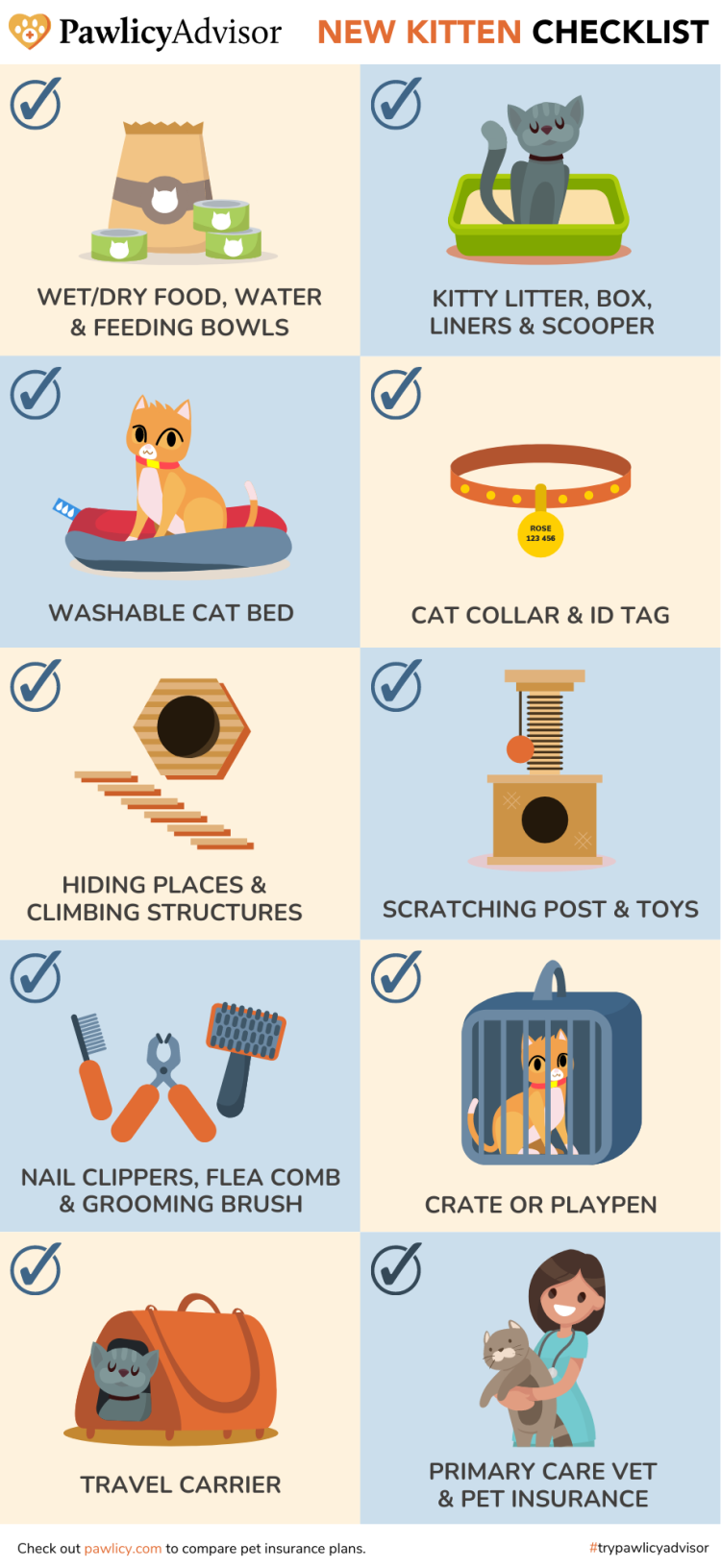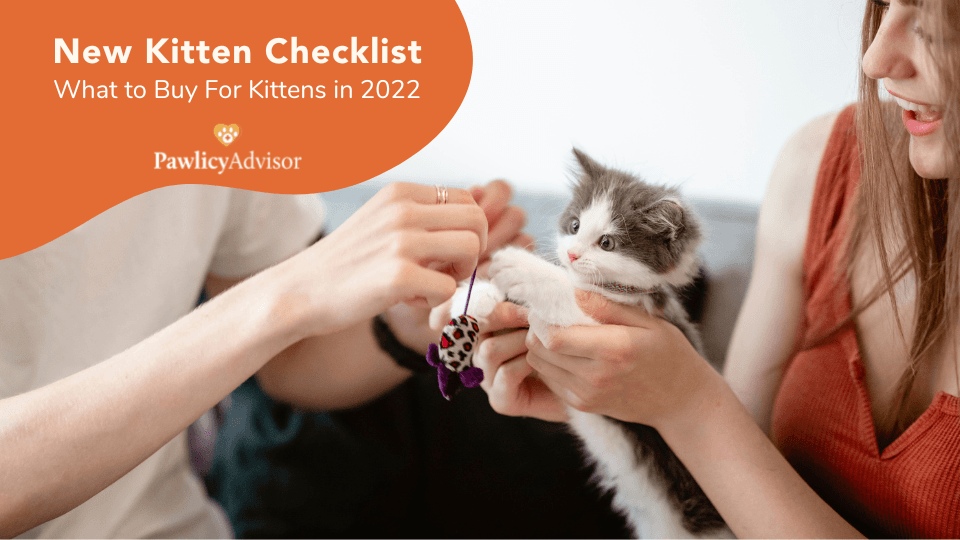If you’re bringing home a kitten, you’ll have many important decisions to make, including which pet supplies to buy for your new family member. But what do kittens need?
Protect Your Kitten With Pet Insurance
It’s your responsibility to provide all the basic kitten essentials your new pet could need. While some of these items may be obvious — such as food, water, a litter box, and kitty litter — there are other considerations many new pet parents aren't aware of when they come into my veterinary office. Plus, with so many options on the market, how do you know what’s best to buy for your kitten at home?
Below, I’ve created a checklist that shows you what to buy for new kittens. You can also save our new kitten checklist PDF to print and save for reference at home.
- Pet food made for kittens
- Kitty litter, box, liners, and scooper
- Cozy cat bed
- Cat collar and ID tag
- Nail clippers, flea comb, and grooming brush
- Scratching post and toys
- Hiding places and climbing structures
- Crate or playpen
- Cat travel carrier
- Primary care veterinarian
What to Buy For New Kittens

1. Pet food made for kittens
With so many products claiming to be the best, choosing the perfect option for your new four-legged friend can be a difficult task. Bear in mind that young kittens have different dietary requirements than adult cats, so be sure to choose a well-balanced, specially-formulated diet for kittens to ensure your pet gets the essential vitamins and minerals they need.
According to Dr. Richard Walther, DVM, “Dry food is much better for the prevention of dental disease, so a caned-only diet is not ideal for cats. A mix of both wet and dry food or a dry-only diet is preferred until they are older and any signs of kidney disease are noted.” If you have trouble choosing, ask your veterinarian for cat food recommendations.
Training treats are optional, but they offer a fun way to reward and bond with your kitten. However, if given in big amounts, they can cause health issues in cats along with other adverse side effects. Treats should never exceed more than 10% of your pet’s daily caloric intake.
Make sure you provide your cat access to fresh water at all times. Some kittens might prefer running water, for example, from a tap or a drinking fountain.
Finally, you’ll need to get food and water bowls. Choose bowls that are sturdy enough so they don’t tip over when your feline friend is eating. The bowls should also be an appropriate size and easy for a kitten to eat from. Since some cats are allergic to plastic, opt for a safe material like stainless steel or ceramic.
2. Kitty litter, box, liners, and scooper
Buying kitty litter and a litter box should be at the top of the list for kitten supplies. To start your kitten out, find a shallow pan so they have no trouble stepping over the higher edges.
You’ll also need to find a kitten litter that’s safe for use. Avoid clumping litter until your pet is older, as these can lead to digestive blockages if swallowed. Also, opt for dust-free litter because it can lead to the development of allergies or respiratory issues like cat asthma. Some felines might prefer litter mats because they find them more comfortable to walk on.
Finally, be sure to stock up on liners and get a good scooper in order to keep the area around the litter box fresh and clean.
3. Cozy cat bed
When it comes to getting a bed for your new kitten checklist, you can start with a small one, but note that they’ll soon outgrow it because the average kitten growth rate is fairly fast. For this reason, it might be wiser to choose a bed that’s designed for a grown cat and uses a roll of blankets to help make it feel more cozy, safe, and enclosed for your tiny kitty.
Another thing to take into consideration when choosing a cat bed is the material’s washability since you will need to wash your pet’s bed frequently to remove odors and prevent the spread of bacteria. Cat beds that have removable covers are the easiest to wash.
4. Cat collar and identification tag
Get your kitten a safety collar with an identification tag and bell so you can always hear where they are. Even if you plan on raising indoor cats, it's still a good idea to identify them with a collar in case they manage to sneak out the door.
Unfortunately, accidental strangulation is a common kitten injury, so choose a cat collar with a breakaway safety snap to prevent them from getting caught on anything while playing or exploring. Check its tightness to ensure that it doesn’t become cut into your kitten’s skin.
Common Accidents & Injuries in Kittens
5. Nail clippers, flea comb, and grooming brush
Having a soft grooming brush and a flea comb on hand is a great way to ensure regular grooming but also enables you to check for parasites and get your pet used to handling.
It’s also a good idea to socialize kittens with nail trimming from an early age. Get a pair of nail clippers that are specifically designed for cats to help the process go as smoothly as possible. If you plan to clip your cat’s nails on a regular basis, consider investing in luxury clippers that will cut through thicker, mature cat nails more easily.
Kitten Socialization Checklist
6. Scratching post and toys
Provide your new pet with a sisal-covered scratching post, cat tree, cat scratching mat, or all three to keep them occupied, provide them with a chance to exercise, and prevent them from damaging your curtains and furniture.
Toys are also a great way to keep your kitten calm, lean, and entertained while you are away. You can leave out safe toys for solo play such as balls, springs, small stuffed catnip toys, and rope toy mice.
For interactive playtime, choose toys that can be used with your supervision, such as fishing pole designs. Remember to change your cat’s toys regularly to prevent them from getting bored.
7. Hiding places and climbing structures
Most kittens love to hide from time to time, usually in dark, warm, and quiet places. Providing a safe hiding place for your kitten can help protect them from hazards around your house.
Learn How to Kitten-Proof Your House
Many kittens like to hide in shoe boxes and cardboard boxes. Place a blanket in the box, tape it closed, and make a hole in the side to make your kitten more comfortable. Many cats also feel comfortable when they’re up high.
Provide cat shelves or furniture your cat can climb up onto and put cushions or boxes on the top that your kitten can hide behind or beneath. Areas of vertical space — including cat trees and window perches — help reduce stress and provide enrichment.
8. Crate or playpen
Not every cat needs a crate or playpen, but they can be used as a safe place if you don’t have a suitable room to contain your pet in while you’re away. If you are keeping your pet in a crate or playpen while you are at work, you will want to make sure there’s enough room for a litter box, food/water bowls, cat bed, and roaming.
9. Cat travel carrier
A cat travel carrier is used for transporting your kitten to play dates, the groomer, and the vet. Regardless of whether you choose a hard-sided or soft-sided carrier, you should make sure it’s durable and that your kitten has enough space to turn around. In general, the carrier should be around 1.5x larger than your cat. Consider a carrier that is easy to remove the lid to make vet visits less stressful.
10. Primary care veterinarian
Your kitten's first stop should be the vet. Ask your primary care veterinarian for a kitten vet checklist. According to AAHA, this list should include medical milestones like deworming, vaccinations, heartworm prevention, having your kitten spayed or neutered, etc.
Remember that cats are naturally curious, which often leads to injuries in kittens that can cost hundreds if not thousands of dollars to treat in the pet emergency room. There are also a number of [cat health issues]((https://www.pawlicy.com/blog/cat-health-issues/) more prevalent in kittens that you should be prepared to pay for. Common kitten illnesses range in severity and treatment cost, but can include everything from the common cat cold to the life-threatening fading kitten syndrome.
List of Common Kitten Illnesses
Pet insurance can help you save money on veterinary care for your new kitten by reimbursing the money you spend on vet bills. Use Pawlicy Advisor to compare pet insurance plans by top providers to ensure your kitten is covered for life and any of the curveballs it throws your way.
Explore Cat Health Insurance Is Pet Insurance Worth It For Cats?
FAQs on Kitten Supplies
What are the must-haves for a kitten?
The list of kitten essentials includes:
- Food
- Water
- Bowls
- Litter box
- Scooper
- Cat bed or mat
- Cat collar and identification tag
- Nail clippers
- Flea comb
- Soft grooming brush
- Scratching post, cat tree, or cat scratching mat
- Toys
- Safe hiding place
- Travel carrier
- Vet care
How to prepare for a kitten
In addition to preparing a kitten starter kit that contains supplies such as cat food, a place to sleep, litter, etc., you should also kitten-proof your house to ensure your pet's safety as well as your own. This includes removing dangerous objects, putting away food cats can’t eat, storing chemicals securely, putting child-proof locks on the cabinet doors, etc.
What to know before owning a kitten
It is important to be fully prepared before bringing a kitten home. Ensure that you have kitten-proofed your house and set up a room with pet care essentials for kittens, including food and water bowls, a bed, toys, and a litter box (use our kitten essentials checklist above to see all the items your new pet will need).
It is recommended to start establishing routines and beginning socialization during the first week. Learn how to introduce your four-legged friend to family, friends, kids, and other animals, as well as how to handle them outdoors once they get their vaccines.
Finally, think about how to find a vet you trust and take your kitten for a check-up a few days after bringing them home. Investing in cat insurance is also recommended as it will cover your kitten's vet bills for illnesses, injuries, genetic conditions, and much more.
